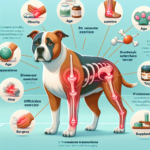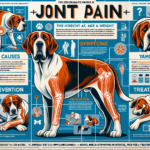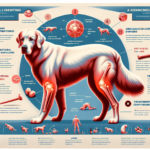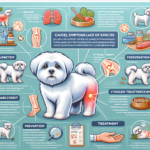Japanese Chin Joint Pain: Causes, Symptoms, Prevention, and Treatment
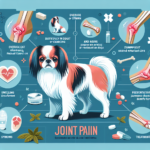
Introduction
The Japanese Chin, also known as the Japanese Spaniel, is a toy breed with a rich history and distinctive characteristics. Originating from Asia, this breed has been a beloved companion of Japanese nobility for centuries. Known for their elegant appearance, with a luxurious coat and a distinctive pushed-in face, Japanese Chins are small, weighing between 4 to 9 pounds, and are characterized by their lively and affectionate nature.
While Japanese Chins are generally healthy, they are prone to certain health issues, including respiratory problems due to their brachycephalic (short-nosed) structure, eye conditions, and joint pain. Joint health is particularly crucial for this breed, as joint pain can significantly impact their quality of life, given their small size and delicate build.
Breed-Specific Joint Pain Risks
Genetic Predisposition
Japanese Chins, like many purebred dogs, have a genetic predisposition to certain joint-related issues. Hip dysplasia, although more common in larger breeds, can still affect Japanese Chins. This condition occurs when the hip joint does not fit properly into the hip socket, leading to pain and arthritis over time. Additionally, patellar luxation, where the kneecap dislocates from its normal position, is a common issue in small breeds, including the Japanese Chin.
Age-Related Risks
As Japanese Chins age, the risk of developing joint pain increases. Arthritis, a degenerative joint disease, is common in older dogs and can cause significant discomfort. For Japanese Chins, signs of joint pain may start to appear as early as middle age, around 5 to 7 years old. Regular veterinary check-ups are essential to monitor joint health as the dog ages.
Activity Level and Joint Stress
Japanese Chins are not as active as some other breeds, but they still enjoy playtime and short walks. However, their small size means that even moderate activity can put stress on their joints. Jumping from heights, such as furniture, can also contribute to joint issues. Owners should be mindful of their dog’s activity level and ensure it is appropriate for their size and age.
Common Symptoms of Joint Pain in Japanese Chins
General Symptoms
- Limping or favoring one leg
- Stiffness, especially after resting
- Reluctance to jump or climb stairs
- Decreased activity or playfulness
- Whining or showing signs of discomfort when touched
Breed-Specific Symptoms
In Japanese Chins, joint pain may manifest as a reluctance to engage in activities they previously enjoyed, such as playing or climbing onto furniture. Due to their small size, even slight changes in behavior can be indicative of joint pain. Owners should be vigilant for any signs of discomfort or changes in mobility.
When to Consult a Vet
If a Japanese Chin shows any signs of joint pain, it is crucial to consult a veterinarian promptly. Early intervention can help manage the condition and prevent further deterioration. Regular veterinary check-ups are also essential for early detection and management of joint issues.
Preventive Measures for Joint Health
Exercise Recommendations
For Japanese Chins, moderate exercise is key to maintaining joint health. Short walks and gentle play sessions are ideal. Avoid high-impact activities or excessive jumping, which can strain their joints. Swimming is an excellent low-impact exercise that can help maintain muscle strength without putting stress on the joints.
Dietary Suggestions
A balanced diet rich in essential nutrients is vital for joint health. Foods containing glucosamine and chondroitin can support joint function. Omega-3 fatty acids, found in fish oil, have anti-inflammatory properties that can help manage joint pain. Consult with a veterinarian to choose the best diet and supplements for your Japanese Chin.
Weight Management
Maintaining a healthy weight is crucial for reducing joint stress. Obesity can exacerbate joint pain and lead to other health issues. Monitor your Japanese Chin’s weight and adjust their diet and exercise routine as needed to keep them at an optimal weight.
Early Screening and Monitoring
Regular veterinary check-ups are essential for early detection of joint issues. Screening tests, such as X-rays, can help identify problems before they become severe. Monitoring your dog’s behavior and mobility can also provide early clues to joint pain, allowing for timely intervention.
Treatment Options for Joint Pain
Non-Surgical Treatments
Non-surgical treatments for joint pain in Japanese Chins include medications, physical therapy, and lifestyle adjustments. Anti-inflammatory drugs and pain relievers can help manage symptoms. Physical therapy, including exercises and massage, can improve mobility and reduce pain. Lifestyle adjustments, such as providing a comfortable bed and avoiding high-impact activities, can also help.
Surgical Options
In severe cases, surgical intervention may be necessary. Procedures such as hip replacement or corrective surgery for patellar luxation can provide significant relief. Consult with a veterinary orthopedic specialist to determine the best surgical options for your Japanese Chin.
Alternative Therapies
Alternative treatments, such as acupuncture, hydrotherapy, and massage, can also benefit Japanese Chins with joint pain. Acupuncture can help reduce pain and inflammation, while hydrotherapy provides low-impact exercise that strengthens muscles without stressing the joints. Regular massage can improve circulation and reduce stiffness.
Lifestyle and Management Tips
Daily Care Routine
A daily care routine for a Japanese Chin with joint pain should include gentle exercise, a balanced diet, and regular monitoring of their condition. Short walks and play sessions can keep them active without overexerting their joints. Providing a comfortable bed and avoiding high-impact activities are also essential.
Modifying the Home Environment
Making the home environment more comfortable for a dog with joint pain can significantly improve their quality of life. Consider using ramps to help them access furniture or beds without jumping. Orthopedic beds provide better support for their joints. Ensure that food and water bowls are at a comfortable height to avoid unnecessary strain.
Long-Term Management
Long-term management of joint pain in Japanese Chins involves regular veterinary check-ups, maintaining a healthy weight, and providing appropriate exercise and diet. Monitoring their condition and adjusting their care routine as needed can help keep them active and happy despite joint pain.
FAQs About Japanese Chins and Joint Pain
What are the early signs of joint pain in Japanese Chins?
Early signs of joint pain in Japanese Chins include limping, stiffness, reluctance to jump or climb stairs, and decreased activity. If you notice any of these symptoms, consult your veterinarian promptly.
Can joint pain in Japanese Chins be prevented?
While genetic predisposition cannot be changed, joint pain can be managed and minimized through proper diet, exercise, weight management, and regular veterinary check-ups. Early detection and intervention are key to preventing severe joint issues.
Are there specific exercises that are better for Japanese Chins with joint pain?
Low-impact exercises, such as short walks and swimming, are ideal for Japanese Chins with joint pain. Avoid high-impact activities and excessive jumping to reduce stress on their joints.
What dietary supplements can help with joint health in Japanese Chins?
Supplements containing glucosamine, chondroitin, and omega-3 fatty acids can support joint health. Consult with your veterinarian to choose the best supplements for your dog.
When should I consider surgery for my Japanese Chin’s joint pain?
Surgery should be considered if non-surgical treatments are not effective and the dog’s quality of life is significantly impacted. Consult with a veterinary orthopedic specialist to determine the best surgical options for your dog.
Conclusion
Joint pain is a common issue in Japanese Chins, but with proper care and management, it can be effectively managed. Regular veterinary check-ups, a balanced diet, appropriate exercise, and weight management are crucial for maintaining joint health. Early detection and intervention can prevent severe joint issues and ensure that your Japanese Chin remains active and happy. By taking preventive measures and consulting with your veterinarian regularly, you can help your Japanese Chin live a comfortable and fulfilling life.

